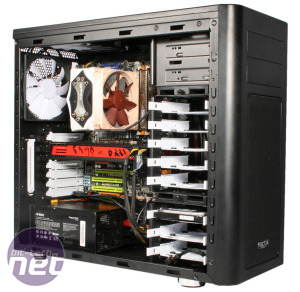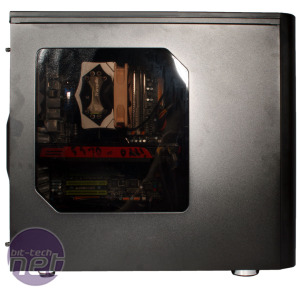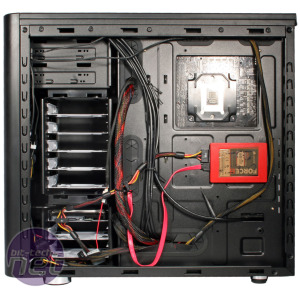
Performance Analysis
At the highest speed setting, the noise level from the Arc Midi R2 is best described as average, with both our hardware and a slight hum from the case fans being audible. This isn't surprising, as noise is able to escape through the front and roof meshed sections and the case lacks the noise dampening materials of its Define brethren. At this setting, the CPU has a delta T value of 49°C. This is a good result; few cases are able to deliver as much cool air to the CPU as SilverStone's high airflow cases that top the charts, but 49°C is still above average, and the dual exhaust set-up favoured by many cases once again works its magic.The GPU, meanwhile, produces a delta T result of 45°C, which again is a very decent result while still being a fair way off the best (and noisiest) leaders. With just three fans, the Arc Midi R2 matches Chieftec's DX-02B, which has five fans (including a 200mm side one), so airflow from the front fan is evidently effective at cooling graphics hardware. Partially blocking this fan with the case's upper drive cage increases this result to 48°C at the same speed setting, so you'll definitely want to leave this out the way if possible.
The Silent Series R2 case fans are all fairly quiet, as you'd expect, and at the 7V and 5V speed settings there's no discernible difference in noise output from a regular listening distance. In fact, it's hard to hear them at all, so with some quieter hardware than ours you could still build yourself a fairly low noise system, although the Define series or Nanoxia's Deep Silence chassis are obviously still better alternatives in this regard.
Each drop in fan speed sees the CPU delta T value increase by 3°C, demonstrating the CPU's reliance on the exhaust fans to keep it cool. However, while the GPU temperature increases by up to 4°C moving from high speed to medium speed, it only changes by a further 1°C when moving to low speed. This suggests that the front fan is much less effective at medium and low speeds, and this is confirmed by the fact that the CPU and GPU results remain the same at these speeds regardless of whether the fan is partially blocked by the drive cage or not (we've omitted these repeat results from the chart).
Conclusion
The Arc Midi R2 is a fine example of a case revision done right, as for the most part the upgrades and changes are sensible and functionally beneficial. The easily removable dust filter, extra USB 3.0 port and integrated fan controller, for example, are all simple but very positive changes that address issues we had with the original chassis. The increased drive cage flexibility and the options this brings to the table in terms of water-cooling are excellent too, and a real stand out feature in a £75 case.The absence of a side panel fan could be a problem for multi GPU enthusiasts, but GPU cooling should still be up to scratch for the majority. While useful in theory, the SSD mounts behind the motherboard tray are somewhat irritating in practice, and the bottom dust filter could also be a little easier to work with. These are very minor niggles, however, and overall the case is a joy to work with. If low noise is a top priority, both Fractal's R4 and Nanoxia's Deep Silence 1 are excellent alternatives (the latter especially for water-coolers), but the Arc Midi R2 strikes a great balance between features, price and quality and is easy to recommend.

-
Value19 / 20
-
Design26 / 30
-
Features18 / 20
-
Cooling22 / 30


MSI MPG Velox 100R Chassis Review
October 14 2021 | 15:04












Want to comment? Please log in.